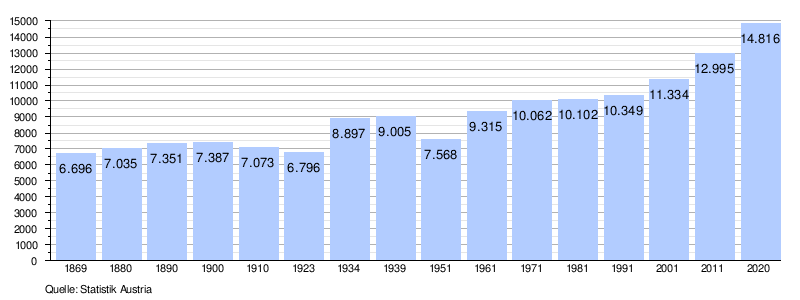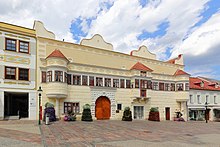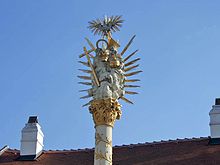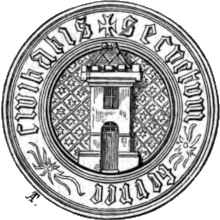Eisenstadt
![]()
The title of this article is ambiguous. For other meanings, see Eisenstadt (disambiguation).
Eisenstadt (pronounced Eisnstod in Bavarian-Austrian, Kismarton 'Little Martin' in Hungarian, Željezno in Croatian, Tikni Marton or Srasta in Romani, Asch in Hebrew) is the capital of the province of Burgenland in Austria. Eisenstadt is a free city - this corresponds to a statutory city of other provinces, the responsible district administrative authority is the mayor. Furthermore, it is the seat of the district administration Eisenstadt-Umgebung as well as the provincial and district court Eisenstadt. The city lies at the foot of the Leithagebirge and is with its 14,895 (as of 1 January 2021) inhabitants the smallest provincial capital in Austria. In terms of population, Eisenstadt ranks 41st on the list of cities in Austria.
Geography
Eisenstadt is situated at the southern foot of the Leithagebirge on a terrace gradually sloping down to the Wulka plain at an altitude of 182 m above sea level (meteorological station 230 m). The east-west course of the terrace was originally followed by the expansion of the town from Oberberg-Eisenstadt in the west to the barracks in the east. Only later did it begin to spread southwards towards the Wulka Plain and in recent decades also northwards up the slopes of the Leithagebirge, where the vineyards gradually had to give way to new settlements.
Protected by the ridge of the Leithagebirge, which rises to over 400 m and is covered by dense deciduous forests, grapes, apricots, peaches and almonds ripen on the climatically favourable slopes. As far as the eye can see, everything is planted with vines, which also surround the town on all sides.
City breakdown
The municipal area comprises the following three localities (number of inhabitants as of 1 January 2021 in brackets):
- Eisenstadt (9208)
- Kleinhöflein in Burgenland (3192)
- Sankt Georgen am Leithagebirge (2495)
The municipality consists of the cadastral communities Eisenstadt, Kleinhöflein im Burgenland, Oberberg-Eisenstadt, St. Georgen and Unterberg-Eisenstadt.
Incorporations
The winegrowing village of Kleinhöflein, situated to the west of Eisenstadt, was part of the Eisenstadt dominion in the Middle Ages, came into the possession of the Esterházy family in the 17th century and was incorporated into the municipality of Eisenstadt on 1 January 1971, as was the municipality of Sankt Georgen am Leithagebirge.
Climate
The long-term average annual temperature (determined in the years 1961 to 1990) is 9.4 °C. The mean value of the year 2007 was 11.8 °C. The average annual precipitation (between 1961 and 1991) is 589 mm. Current values can be found on the website of the weather values Burgenland of the ZAMG.
| Monthly average temperatures and precipitation for Eisenstadt
Source: ZAMG climate averages 1981 - 2010 | |||||||||||||||||||||||||||||||||||||||||||||||||||||||||||||||||||||||||||||||||||||||||||||||||||||||||||||||||||||||||||||||||||||||||||||||||||||||||||||||||||||||||||||||||||||||||||||||||||||||||||||||

Climate diagram
History
Before the birth of Christ, the area was part of the Celtic kingdom of Noricum and belonged to the surroundings of the Celtic hilltop settlement of Burg on the Schwarzenbach Burgberg.
Later, under the Romans, today's Eisenstadt lay in the province of Pannonia.
Finds prove that the Eisenstadt area was already settled in the Hallstatt period. Somewhat later the Celts and Romans settled here. At the time of the migration of peoples, various Germanic peoples and the Huns settled in the Eisenstadt area. Around 800, at the time of Charlemagne, settlement by the Bavarians began. Eisenstadt first appeared in 1118 as a "castrum ferrum". The first written mention was in 1264 as "minor Mortin" (corresponding to Hungarian "Kismarton"). The Eisenstadt area was one of the westernmost parts of the Kingdom of Hungary.
In 1373 the town came into the possession of the Hungarian noble family Kanizsai. The family had the walls fortified and built a moated castle within the walls. The name "Eysenstat" (strong, iron, hence Eisenstadt) also comes from this time. In 1388 Eisenstadt was granted market rights. In 1445 Duke Albrecht VI acquired the city; for the next 150 years Eisenstadt remained under Austrian administration (as if it were part of what later became Lower Austria), administered from Vienna. During the Turkish War, the Turks captured Eisenstadt in 1529 and 1532 in their advance on Vienna.
The Hungarian nobility demanded that the Habsburgs, who were by now also hereditary kings of Hungary, fully reintegrate western Hungary into Hungary and end the Austrian direct administration. In order to win over the Hungarian noble family of Esterházy to the House of Habsburg, they were enfeoffed in 1648 by the Holy Roman Emperor Ferdinand III in his capacity as King of Hungary with, among other things, the region of Eisenstadt, and in 1687 they were elevated to the status of Imperial Princes by his successor Leopold I. The Esterházy dynasty changed from a family of princes to a family of princes. The princely dynasty changed the image of the city with lasting effect through lively building activity.
In parallel, Eisenstadt (in its then extent within the city walls) was elevated by the Emperor on 26 October 1648, at the urgent request of the citizenry, to the status of a royal free city, subject to no one but the King, and paid for it 16,000 florins and 3,000 buckets of wine worth 9,000 florins. Outside the city walls, in territory administered by him, Paul I Esterházy de Galantha settled in 1670, immediately adjacent to what was then Eisenstadt and in six surrounding villages, the so-called Seven Communities, about 3,000 Jews who had previously been expelled from Vienna. Samson Wertheimer (1658-1742), who worked as a court factor in Vienna, acted as rabbi in Eisenstadt.
The Esterházy family soon developed into one of the richest noble families in Central Europe and had numerous castles to choose from. They chose Eisenstadt as their princely seat, converted the former fortified castle into a prestigious palace and maintained a very lavish, impressive court, which even led to visits by Empress Maria Theresa. The appointment of Joseph Haydn as princely court conductor in the 1760s marked the beginning of a 30-year period of artistic splendour. In 1809 Eisenstadt was occupied by French troops during the Coalition Wars.
From 1865 to 1898 the House of Esterházy had to forego its customary grand representational expenditure, as it had overstretched itself financially and had only escaped bankruptcy with imperial assistance. Things fell quiet in Eisenstadt. The West Hungarian city was culturally oriented towards Vienna and tried to avoid the Magyarization pursued by Budapest in the last decades of the 19th century. In 1897 Eisenstadt was connected to the Hungarian railway network.
After the First World War and the dissolution of Austria-Hungary, a three-year struggle took place over the future state affiliation of "German West Hungary" and thus of Eisenstadt. As a result of the peace treaties of St. Germain in 1919 with Austria and of Trianon in 1920 with Hungary, the area became part of Austria in 1921 as Burgenland (the new name). Ödenburg (Sopron in Hungarian), which was originally intended to be the provincial capital, was added to Hungary as a result of a referendum. Instead of Ödenburg, Eisenstadt was therefore designated the seat of the Burgenland provincial government on October 19, 1925, and thus de facto the provincial capital. However, it was not mentioned as such in the Burgenland constitution at that time.
A Roman Catholic Apostolic Administrature was established in Eisenstadt so that the Burgenlanders would no longer be subject to a Hungarian bishop. The surrounding communities were annexed to the Free City of Eisenstadt: Eisenstadt-Schlossgrund in 1923, Unterberg-Eisenstadt in 1938, Oberberg-Eisenstadt in 1939, Kleinhöflein and St. Georgen in 1970.
To mark the 200th anniversary of Haydn's birth, the Haydn Foundation, in cooperation with the then "Mittelstelle Deutscher Jugend in Europa" (Central Office of German Youth in Europe), organized a large Haydn celebration in Eisenstadt in July 1932 with a distinctly nationalistic-German character. Young people from all German-speaking settlement areas in Central Europe brought soil from their homeland (e.g. Helgoland), from important historical sites (e.g. Wartburg Castle near Eisenach), from the graves of historically important Germans (e.g. the imperial tombs of Speyer Cathedral and the grave of Martin Luther), from memorials (e.g. Friedrich Schiller's birthplace), and from the graveyard of the German Emperor. Friedrich Schiller's birthplace in Marbach am Neckar), battlefields (e.g. the Monument to the Battle of the Nations and the Langemarck Cemetery) and workplaces (e.g. the Warndt region in the Saarland) to Eisenstadt as a declaration of national German identity. The Haydn memorial in the form of a large-scale cube urn bore the inscription "Jugend kam aus allen Marken und brachte Erde der Heimat, Joseph Haydn, dem Sänger des Liedes der Deutschen, zur Ehre, dem ewigen Reiche der Deutschen zum Pfand".
During the Nazi era, Burgenland was dissolved; its northern part with Eisenstadt became part of the Niederdonau Gau. The Jewish citizens of Eisenstadt were expelled or murdered. During the Second World War Eisenstadt was bombed once, resulting in 40 deaths. In 1945, the Red Army captured Eisenstadt, and the city remained under Soviet occupation until 1955. In 1956 Eisenstadt became the seat of the Evangelical Lutheran Superintendency of Burgenland and in 1960 the seat of the Roman Catholic Diocese of Eisenstadt.
It was not until 1965 that Eisenstadt enshrined the status of provincial capital in the city constitution. In the provincial constitution it took place at all only in 1981.
Population development

After the annexation of Burgenland to Austria, the ethnic and linguistic structure of the population
changed considerably. In 1910 the proportion of Magyars was still around 27%; in 1934, however, the proportion of Hungarian-speaking inhabitants was around 5%. This change is due on the one hand to the retreat of many Magyar officials, military personnel, etc. to Hungary, and on the other hand to the linguistic - national self-definition of the inhabitants.
In the last census, Eisenstadt (excluding districts) had a share of 2.7% and 4.0% Hungarian- and Croatian-speaking population (resident population with Austrian citizenship), respectively. The latter is mainly due to an influx from the surrounding Croatian and mixed-language communities in recent decades.
The denominational composition of the population also changed: the number of Protestants rose from 52 in 1890 to 493 in 1961. The number of Jews was 906 in 1836 and then fell steadily to 445 in 1923. The emigration was mainly towards Vienna. Of the more than 400 Jews of Eisenstadt, about 250 survived the Shoah. Only two Eisenstadt Jews returned after 1945.

City Hall in Eisenstadt

Plague column

Seal of Eisenstadt, 14th century, Secretvm ferree civitatis
Search within the encyclopedia